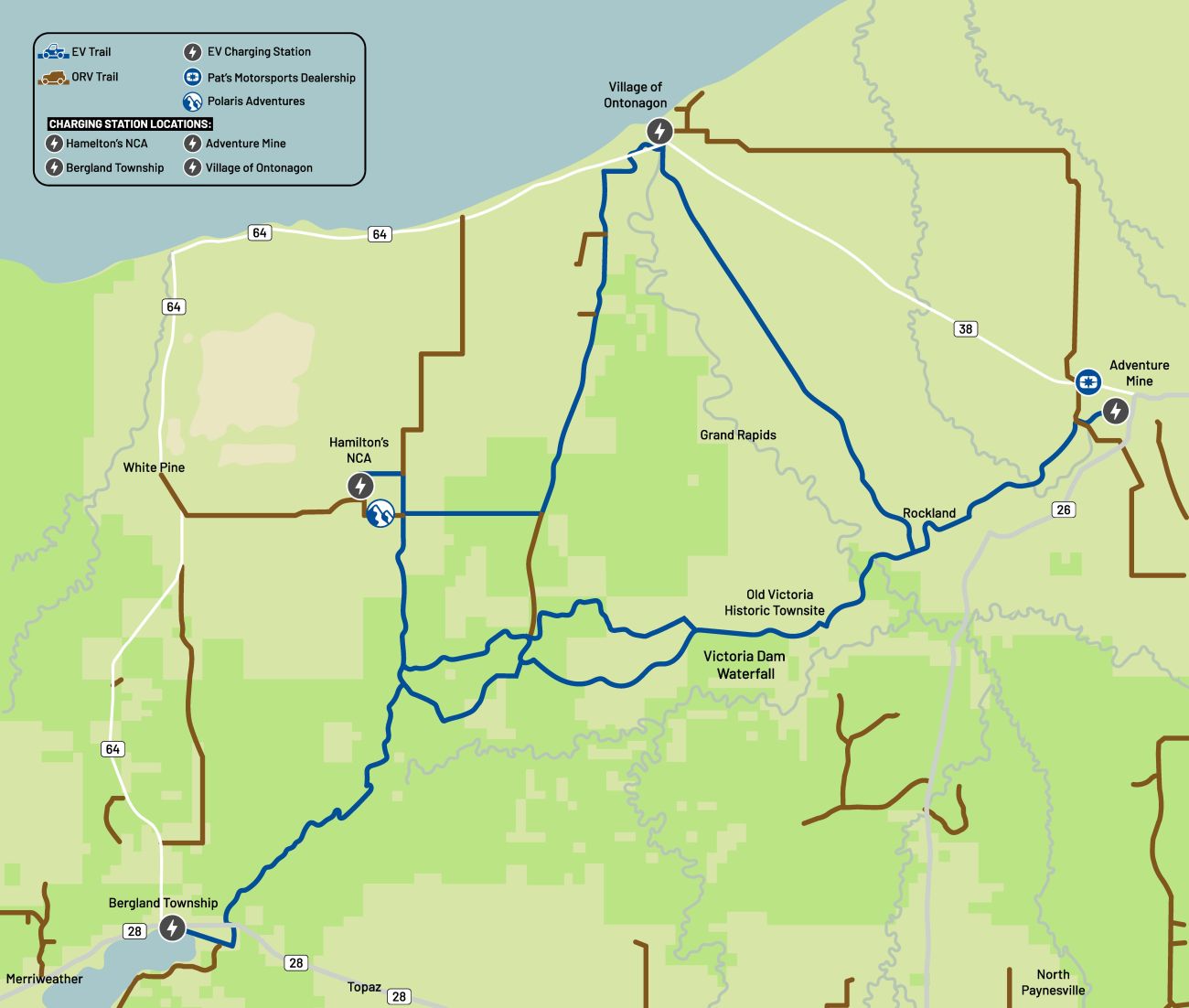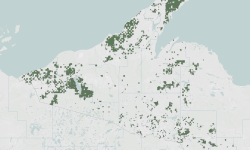Michigan opens first public EV charging network for off-road vehicles

- The nation’s first public EV charging network for off-road vehicles is now open in Michigan’s Upper Peninsula
- At just four chargers, it’s modest
- Proponents say they hope for continued expansion, but it may be a while before the average trail-rider goes electric
Michigan’s nascent electric transportation sector is expanding to the trail-riding crowd, with a new charging network designed specifically for electric off-road vehicles.
The four free-to-use public chargers, which officially opened in the western Upper Peninsula in June, are believed to be the nation’s first for off-road vehicles.
Located in the communities of Ontonagon, White Pine, Bergland and Greenland, the network is modest, supporting about 100 miles of trails. That’s a small fraction of the U.P.’s vast multi-thousand-mile ATV and snowmobile trail network.
But proponents see it as an important first step toward making EVs accessible to the average trail-rider.
“It’s a really interesting opportunity for us to learn more about what the future of electric power sports could look like,” said Jess Rogers, a spokesperson for Minnesota-based Polaris Inc., which developed the network with a $700,000 grant from the Michigan Economic Development Corporation.
Proponent touts ‘instant torque’
The chargers dot the popular Pioneer ORV trail system, which traverses the Porcupine Mountains region, passing waterfalls, old mines and other attractions.
Related:
- Michigan officials mull more access for e-bikes on state trails
- Michigan to invest $110M in EV chargers. At $134K a plug, it won’t go far
- EV transition a slow go in Michigan. It needs 100,000 chargers, has 3,300
Local outfitter Hamilton’s North Coast Adventures has partnered with Polaris to offer electric ORV rentals for use on the trails. Owner Steve Hamilton said he’s not motivated by environmental concerns. Rather, he said, EVs simply offer a superior ride, with less noise, more power and less maintenance.
“They're instant torque," Hamilton said. “Anybody that's performance-minded like myself, I love turbochargers and horsepower and going fast, and these things do all of that.”

Why it matters
Climate experts have warned that society needs to stop burning fossil fuels by midcentury or risk dire consequences from climate change. The transportation sector is a major culprit.
America’s recreational vehicles — like ORVs, snowmobiles and pleasure boats — are relatively minor sources of carbon dioxide emissions, far outnumbered by U.S. passenger vehicles that have a carbon footprint comparable to the entire country of Japan.
But on a per-mile basis, they are far bigger polluters. That’s because two-stroke engines, which are common in off-road vehicles, burn gas inefficiently compared with the four-stroke engines found in cars.
An ATV, for example, can emit 30 times the hourly air pollution of an automobile. For a snowmobile, it’s 100 times more.
And Michiganders love them. There are 287,000 registered ORVs in the state, along with 178,000 registered snowmobiles and nearly 810,000 registered recreational boats.
It’s not just ORVs
The off-road vehicle charging network is part of a broader push to electrify Michigan’s outdoor recreation scene.
Michigan Gov. Gretchen Whitmer last year launched the “Fresh Coast Maritime Challenge,” doling out $506,000 in grants to expand e-boating and related charging infrastructure in Michigan.
Electric bicycles are also gaining popularity, prompting the state Department of Natural Resources to consider opening 3,000 miles of trails to them.
And the National Park Service has announced a plan to reach net-zero emissions at all parks bordering Lake Superior, starting with electrifying trail and grounds maintenance equipment like lawnmowers.
“Electrification is something that every industry is trying,” Hamilton said.

We’re a long way from all-electric
While the chargers mark a milestone, it would take dozens more of them to make Michigan’s entire 4,000-mile ORV trail network accessible to electric vehicles.
“There's so much incredible riding to do,” Hamilton said. ‘And you can get to it, but you can't get back from it because of the charging infrastructure.”
Electric ORVs have a range of about 80 miles on a full charge. While that makes them a great fit for the rental market, in which drivers take short out-and-back day trips, it won’t work for most ORV enthusiasts, said Karen Middendorp, executive director of the Michigan Snowmobile & ORV Association.
“Is there a spot in the future for it?” Middendorp said. “Yeah, I believe there is. Are we there? No.”
Even if the charging network expanded, Middendorp said, there may be barriers to widespread EV adoption.
Many riders relish the freedom of traveling into dense forests far from the nearest restaurant or store. It may be possible to install chargers in those far-flung locations, she said, but “when it takes two, three, four hours to charge that unit, what are you going to do in that time? Stand outside for hours?”
Polaris officials said they aim to use their experiment in Michigan to refine the company’s EV strategy. In addition to renters, Rogers said the company sees EVs as a win for farmers and other customers who use ORVs as utility vehicles that rarely leave their property.
As for whether Polaris could soon expand its push into the recreational space, that depends how well the U.P. EV charging experiment goes.
“We’re interested in seeking what the results are and what the appetite is,” Rogers said, “And then we’ll continue to test and learn from there.”
Michigan Environment Watch
Michigan Environment Watch examines how public policy, industry, and other factors interact with the state’s trove of natural resources.
- See full coverage
- Subscribe
- Share tips and questions with Bridge environment reporter Kelly House
Michigan Environment Watch is made possible by generous financial support from:
Our generous Environment Watch underwriters encourage Bridge Michigan readers to also support civic journalism by becoming Bridge members. Please consider joining today.
See what new members are saying about why they donated to Bridge Michigan:
- “In order for this information to be accurate and unbiased it must be underwritten by its readers, not by special interests.” - Larry S.
- “Not many other media sources report on the topics Bridge does.” - Susan B.
- “Your journalism is outstanding and rare these days.” - Mark S.
If you want to ensure the future of nonpartisan, nonprofit Michigan journalism, please become a member today. You, too, will be asked why you donated and maybe we'll feature your quote next time!






